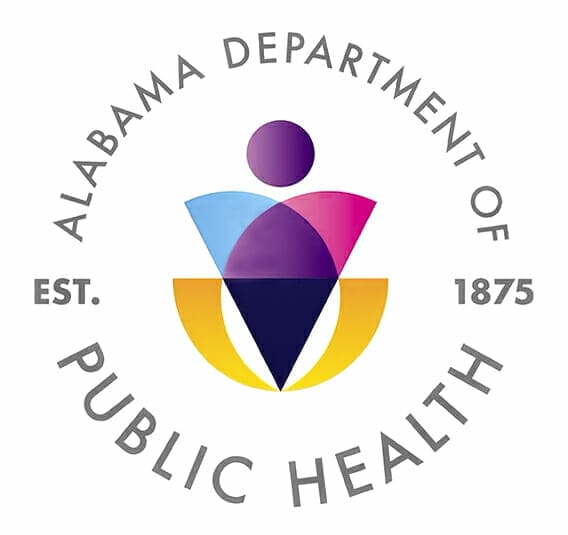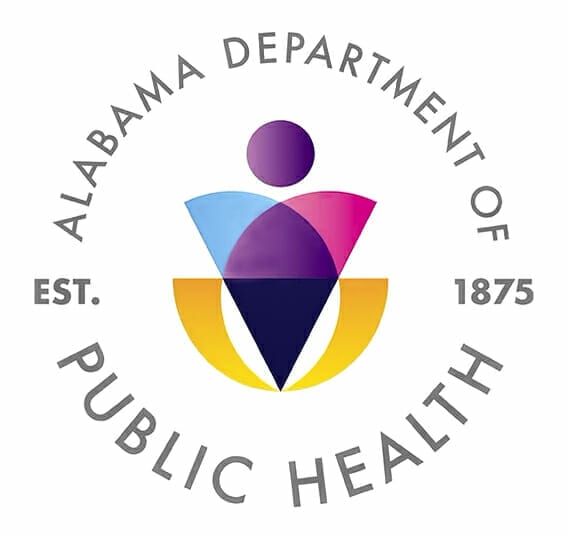Alabama Department of Public Health
The Alabama Department of Public Health (ADPH) is the primary state agency for regulating and overseeing issues relating to the health of Alabama‘s citizens. Its mission is to promote, protect, and improve the health of individuals and communities in Alabama. ADPH is composed of a number of issue-specific bureaus covering a variety of public health issues, including immunizations, emergency preparedness, injury prevention, radiation control, and prescription drug monitoring.
ADPH is headquartered in Montgomery, Montgomery County, and is headed by the State Health Officer, who oversees its operations and supervises the agency’s employees and activities. ADPH is overseen by the State Board of Health, which is comprised of members of the Medical Association of the State of Alabama (MASA). The State Board of Health sets broad policies for public health in the state that are overseen and implemented by the State Committee of Public Health, which also elects the State Health Officer. This committee is composed of 16 members, with 12 of them being the members of MASA’s Board of Censors and the remaining four being the heads of four state health councils: Dental Health, Animal and Environmental Health, Prevention of Disease and Medical Care, and Health Costs, Administration, and Organization. ADPH has an operating budget of between $300 million and $500 million.
History
The establishment of the national Public Health Act of 1848 influenced advancements in public health in the United States, but Alabama did not establish ADPH until much later. In 1872, physician Jerome Cochran submitted a plan to organize a state board of health in Alabama at a meeting of MASA, which was adopted in 1873. Soon after, both Alabama and the nation as a whole were battling epidemic disease outbreaks such as cholera. ADPH was officially founded in 1875, and Alabama became the first state in the nation to establish a health department in each of its counties. In 1877, Alabama created the office of the State Health Officer, and the first head of the agency took office in 1879.
By the twentieth century, federal activities expanded in the public health arena. With remarkable success in lowering death rates due to contagious diseases, public health agencies moved their focus from disease prevention to promotion of overall health. As these activities expanded, so did federal and state funding requirements. ADPH turned its attention to health issues such as infant mortality, heart disease, and the prevention of sexually transmitted diseases.
Purpose
ADPH oversees public health policy for the entire state. Some of the more significant services include tracking and preventing communicable diseases, issuing policies and procedures to prevent illnesses among Alabamians, and investigating public places, such as restaurants and businesses, that may pose health hazards. In addition, the agency provides health care services to the citizens of the state and registers all births, deaths, marriages, and divorces. ADPH also provides and enforces health care standards and services.
Within the past several decades, ADPH has helped to reduce infant mortality, reduce the number of children who are uninsured through its ALL Kids program, and fill the health care gap for those who cannot obtain the services they need. One of the most significant challenges for ADPH is the increasing rates of obesity among the state’s citizens. ADPH has created a State Obesity Task Force specifically to combat this epidemic with initiatives that include Scale Back Alabama, Get Moving Alabama, and ReThink Your Drink.
Through these efforts, ADPH is focusing on increasing the use of technology and data, improving access to care and good nutrition, and developing efforts to increase physical activity among Alabamians.
Over the past decade, ADPH has lost a significant amount of both state and federal funding, in large part from spending all its funds allocated from the American Recovery and Reinvestment Act of 2009. Officials anticipate continued reductions in funding in the future, so they are planning accordingly for this impact on the agency. Additionally, Gov. Robert Bentley declined to expand Medicaid, and thus the many Alabamians who fall below the federal poverty level cannot receive health care coverage because they are still ineligible for Medicaid, resulting in more uninsured people.
ADPH has grown significantly and expanded the reach of its programming. The agency serves all counties in some shape or form, but lack of funding and other policy and political issues hamper these efforts. Currently, Alabama’s health ranking is 46th in the nation with high infant mortality, diabetes, and cardiovascular disease rates as key challenges. With nearly 20 percent of the state’s population living in poverty, the relationship between poverty and health has been clearly documented. ADPH is working to bridge the gap in access to care by taking health services to rural areas in the state with its Office of Primary Care and Rural Health and through other programs.






